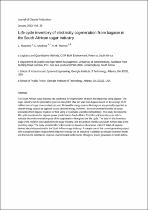 ResearchSpace
ResearchSpace
Life cycle inventory of electricity cogeneration from bagasse in the South African sugar industry
JavaScript is disabled for your browser. Some features of this site may not work without it.
- ResearchSpace
- →
- Research Publications/Outputs
- →
- Journal Articles
- →
- View Item
| dc.contributor.author |
Mashoko, L

|
|
| dc.contributor.author |
Mbohwa, C

|
|
| dc.contributor.author |
Thomas, VM

|
|
| dc.date.accessioned | 2012-11-20T06:45:32Z | |
| dc.date.available | 2012-11-20T06:45:32Z | |
| dc.date.issued | 2013-01 | |
| dc.identifier.citation | Mashoko, L, Mbohwa, C, Thomas, VM. 2013. Life cycle inventory of electricity cogeneration from bagasse in the South African sugar industry. Journal of Cleaner Production, vol. 39, pp 42-49 | en_US |
| dc.identifier.issn | 0959-6526 | |
| dc.identifier.uri | http://www.sciencedirect.com/science/article/pii/S0959652612004568 | |
| dc.identifier.uri | http://hdl.handle.net/10204/6334 | |
| dc.description | Copyright: 2013 Elsevier. This is an ABSTRACT ONLY. The definitive version is published in the Journal of Cleaner Production, vol. 39, pp 42-49 | en_US |
| dc.description.abstract | The South African sugar industry has a potential for cogeneration of steam and electricity using bagasse. The sugar industry has the potential to generate about 960 MW per year from bagasse based on the average of 20 million tons of sugar cane crushed per year. Renewable energy sources like bagasse are generally regarded as cleaner energy sources as opposed to coal-derived energy. However, the environmental benefits of power production from bagasse must be verified using a systematic scientific methodology. This study develops the life cycle inventories for bagasse power production in South Africa. The life cycle inventory can help to evaluate the environmental impacts of the cogeneration throughout the life cycle. The data for this inventory stage of the research was supplied by the sugar industry, and the analysis mostly uses South African data in the inventory stage. The study presents life cycle inventories based on a functional unit of 1 GWh of bagasse-derived electricity produced in the South African sugar industry. A comparison of the current generating output with a proposed higher output shows that more energy can be produced in addition to reduced inventory levels and this has the potential to improve environmental performance of bagasse power generation in South Africa. | en_US |
| dc.language.iso | en | en_US |
| dc.publisher | Elsevier | en_US |
| dc.relation.ispartofseries | Workflow;9701 | |
| dc.subject | Bagasse power lifecycle inventories | en_US |
| dc.subject | South African sugar power | en_US |
| dc.subject | Bio power environmental sustainability | en_US |
| dc.subject | Bioenergy | en_US |
| dc.subject | Bagasse | en_US |
| dc.subject | Sugar cane | en_US |
| dc.subject | Alternative energy | en_US |
| dc.title | Life cycle inventory of electricity cogeneration from bagasse in the South African sugar industry | en_US |
| dc.type | Article | en_US |
| dc.identifier.apacitation | Mashoko, L., Mbohwa, C., & Thomas, V. (2013). Life cycle inventory of electricity cogeneration from bagasse in the South African sugar industry. http://hdl.handle.net/10204/6334 | en_ZA |
| dc.identifier.chicagocitation | Mashoko, L, C Mbohwa, and VM Thomas "Life cycle inventory of electricity cogeneration from bagasse in the South African sugar industry." (2013) http://hdl.handle.net/10204/6334 | en_ZA |
| dc.identifier.vancouvercitation | Mashoko L, Mbohwa C, Thomas V. Life cycle inventory of electricity cogeneration from bagasse in the South African sugar industry. 2013; http://hdl.handle.net/10204/6334. | en_ZA |
| dc.identifier.ris | TY - Article AU - Mashoko, L AU - Mbohwa, C AU - Thomas, VM AB - The South African sugar industry has a potential for cogeneration of steam and electricity using bagasse. The sugar industry has the potential to generate about 960 MW per year from bagasse based on the average of 20 million tons of sugar cane crushed per year. Renewable energy sources like bagasse are generally regarded as cleaner energy sources as opposed to coal-derived energy. However, the environmental benefits of power production from bagasse must be verified using a systematic scientific methodology. This study develops the life cycle inventories for bagasse power production in South Africa. The life cycle inventory can help to evaluate the environmental impacts of the cogeneration throughout the life cycle. The data for this inventory stage of the research was supplied by the sugar industry, and the analysis mostly uses South African data in the inventory stage. The study presents life cycle inventories based on a functional unit of 1 GWh of bagasse-derived electricity produced in the South African sugar industry. A comparison of the current generating output with a proposed higher output shows that more energy can be produced in addition to reduced inventory levels and this has the potential to improve environmental performance of bagasse power generation in South Africa. DA - 2013-01 DB - ResearchSpace DP - CSIR KW - Bagasse power lifecycle inventories KW - South African sugar power KW - Bio power environmental sustainability KW - Bioenergy KW - Bagasse KW - Sugar cane KW - Alternative energy LK - https://researchspace.csir.co.za PY - 2013 SM - 0959-6526 T1 - Life cycle inventory of electricity cogeneration from bagasse in the South African sugar industry TI - Life cycle inventory of electricity cogeneration from bagasse in the South African sugar industry UR - http://hdl.handle.net/10204/6334 ER - | en_ZA |





